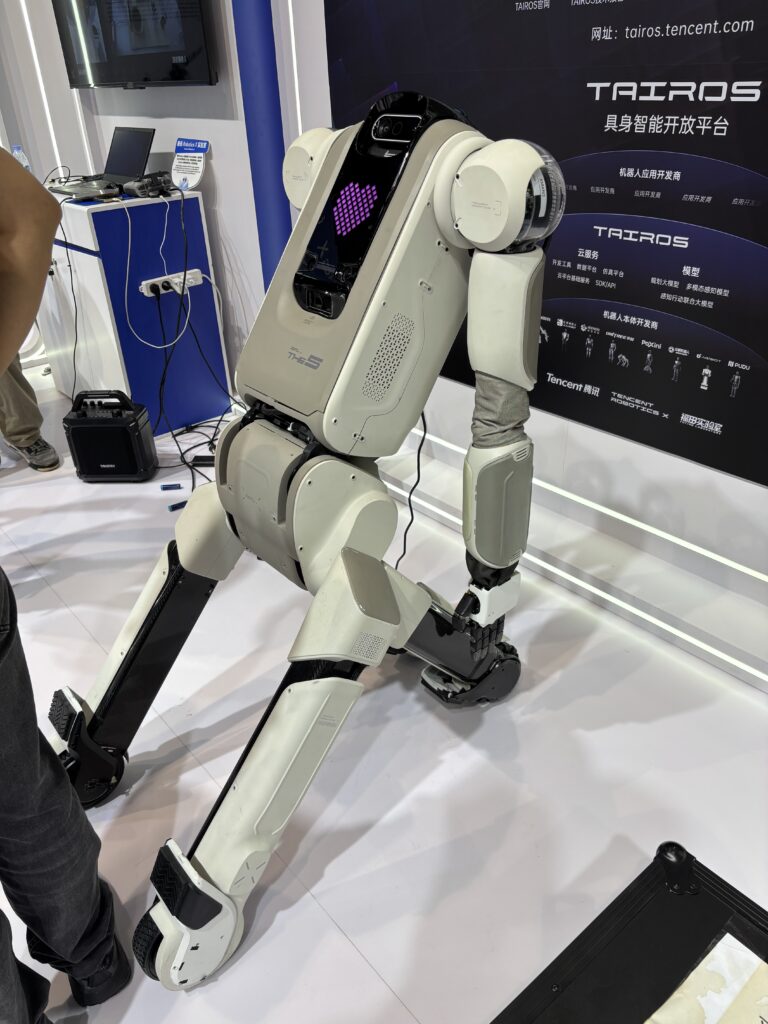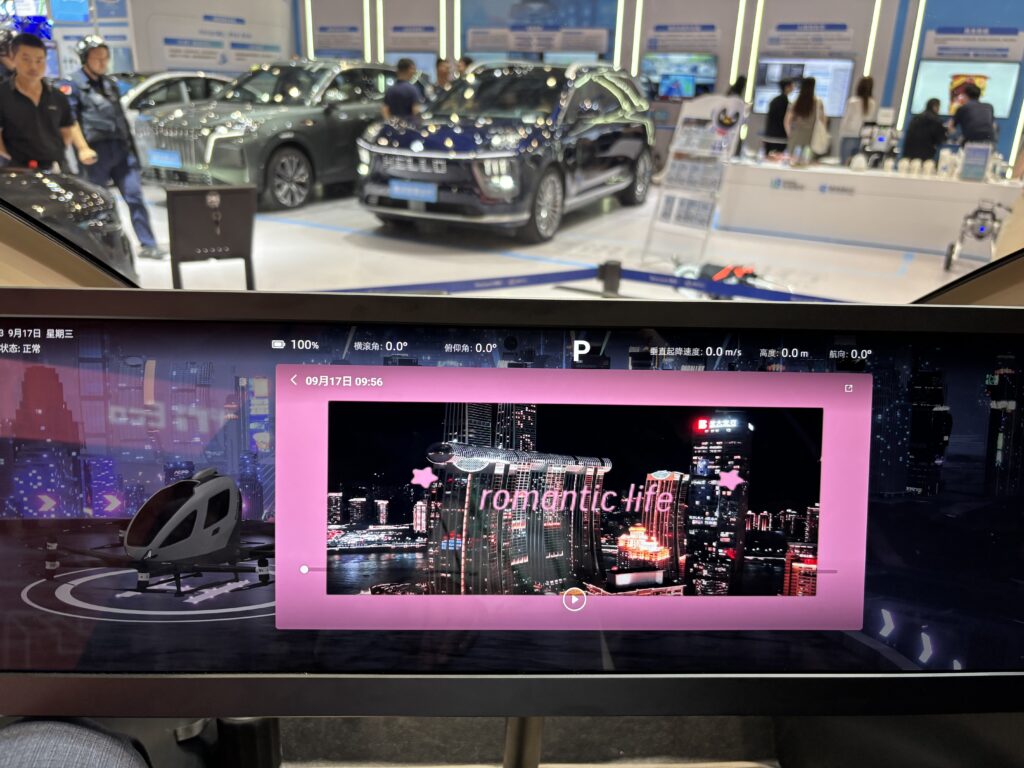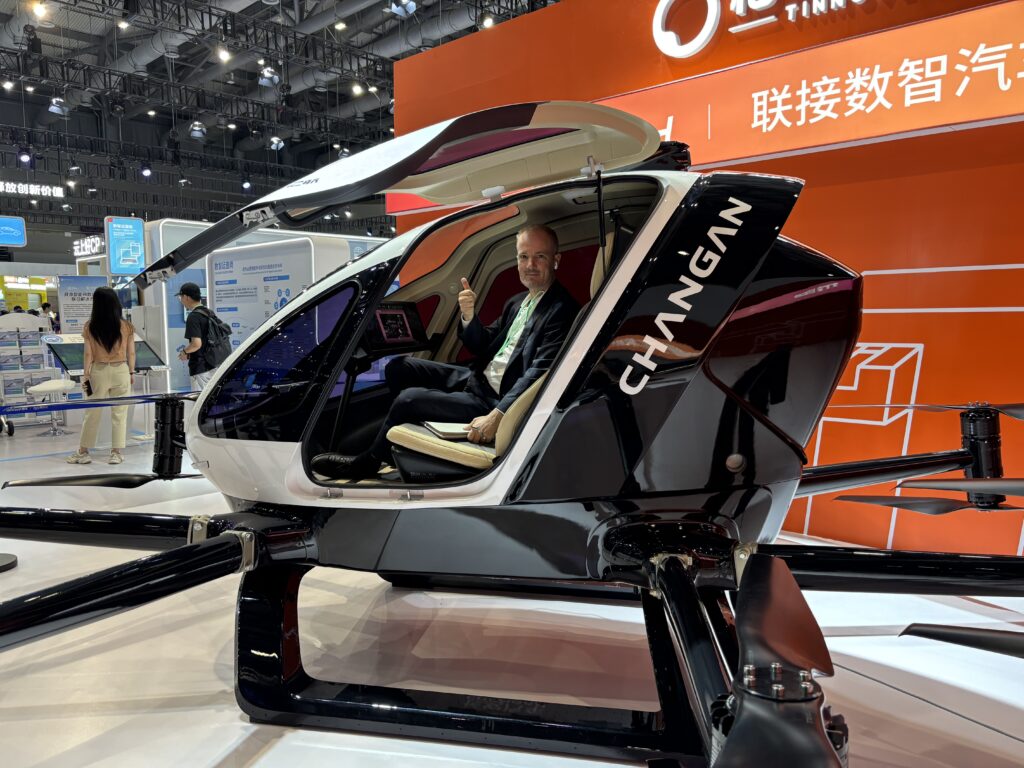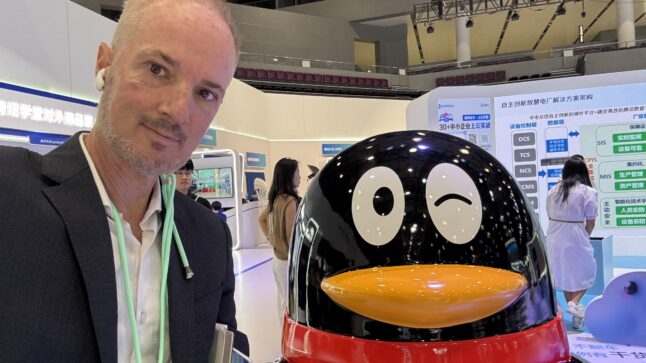This week’s podcast is a summary of my visit to the Tencent Cloud Data Ecosystem Summit in Shenzhen.
You can listen to this podcast here, which has the slides and graphics mentioned. Also available at iTunes and Google Podcasts.
–
Here is the link to the TechMoat Consulting.
Here is the link to our Tech Tours.
Here are some photos from the summit.





—–
Related articles:
- Two Lessons from My Visit to Tencent Cloud (1 of 2) (Tech Strategy)
- Tencent Cloud and Mini Programs Go International. Lessons from My Visit to Tencent HQ. (2 of 2) (Tech Strategy)
- How Amap Beat Baidu Maps. My Summary of the Alibaba Playbook. (Tech Strategy – Podcast 252)
- Scale Advantages Are Key. But Competitive Advantages Are More Specific and Measurable. (Tech Strategy)
From the Concept Library, concepts for this article are:
- AI
- Cloud
From the Company Library, companies for this article are:
- Tencent Cloud
———transcription below
Welcome, welcome everybody. My name is Jeff Towson and this is the Tech Strategy Podcast from Techmoat Consulting. And the topic for today, my takeaways from the Tencent Cloud Summit. A week ago, there was a pretty awesome Tencent Cloud event in Shenzhen. I went out for that. It’s kind of two events in one actually. It’s sort of Tencent Cloud goes international. which they talked about a lot. And then it’s also the Data Ecosystem Summit, which is more like the AI, more traditional cloud stuff. I’m going to talk about the ladder there. But yeah, it was pretty awesome. Flew out several days. It’s going to be sort of short list of my takeaways. I’ve got a couple interviews I did there that are going to be published, I guess, in the next day or so. I’ll send those out with one of their vice presidents and then one of their retail partners in Hong Kong. Pretty useful. I found it really insightful. So, I’ll summarize those and get that done out in the next day or so. But today’s just sort of my takeaways, my short list of what I’m going to dig deeper into basically. Yeah that’ll be the topic for today. , let’s see. got to do my disclaimer and Nothing in this podcast or my writing a website is investment advice the numbers and information for me and any guess may be Incorrect the views and opinions express may no longer be relevant or accurate overall investing is risky This is not investment legal or tax advice do your own research And with that let’s get into the topic Now there’s no real concepts for today. This is just AI meets cloud, which is really kind of dead center for me right now and things I’m focused on. Because yeah, like AI is awesome. It’s huge. It’s going to have all this impact. But it’s kind of hard to get a good read on what’s a cool pilot and what’s actually changing the numbers in terms of a business’s performance and its competitive sort of strength. When we look at digital, which is a lot of what I’ve been focused on these last 10 years, okay, we have a good track record we can look at. You I can pull public company data and see the results after the sort of hype has settled down. Well, I were kind of early stage, hard to know. Now, if you’re a venture capitalist, you’ve got a pretty good… bird’s eye view into what’s going on because you see all the deals going across your desk and you see their numbers. Okay, I don’t have that. So, my little solution to that is I’ve been focusing on AI cloud companies and seeing what large companies and medium and small companies are actually adopting, piloting and then scaling up, which is the key step. So, for about a year or two now, I’ve been focused on the big four of China, which would be Alibaba cloud, Tencent cloud, Huawei cloud, Baidu cloud. you know that’s kind of my shortlist and getting you get real good insight into what’s actually being built as opposed to just press releases and things which are interesting but you know a lot of those fade away and don’t end up moving the needle in terms of the company’s operating performance let alone financial performance so anyways I set out to sort of become one of the world’s experts on Tencent cloud as well as a couple of the others. you know, I think I’m moving down the path pretty good. So, I was out there and I’ve met with, you know, the problem with Tencent is it’s very big. It’s lots of businesses together. So, you know, you got WeChat, that’s a whole world in itself. You got the gaming business, which is massive. That’s a whole world in itself. You got cloud. That’s a big deal. You got all the media and content companies. They got movies. They got TV shows. They got literature. They got music. They got QQ. They got payment. They got financial services. They got WeBank. I mean, it is a sprawling digital, you know, sort of conglomerate. So, it’s a little actually, you know, I’ve met with a bunch of these groups in the last year, everything from like Tencent Healthcare to WeChat to gaming and just digging into the various pieces. But the one that cuts across all of them is AI. Right? Well, the product, the tech, it’s going into everything across all the divisions. And the best way to get a handle on that is AI cloud. Look at their cloud business. And you can see not only what they’re deploying within their own company. but you can also get a sense of what customers and clients are deploying. So that’s kind of where I’ve been focused and it’s pretty awesome to go out there and spend a couple days interviewing and hunting around the summit. I took a million notes. So, this podcast is really sort of the distilled version of my, I don’t know how many pages of notes, like half a book of notes. So, I’ll just go through them one by one what got my attention, what I’m going to dig further into. Half this conference was half about Tencent Cloud going international, which they’re doing. It’s really interesting. That’s what the articles coming are about. And then the other side is intelligence. So, it’s sort of international plus intelligence. Yeah, they’re basically all in. They’re all in on AI and they’re moving much faster in AI agents than I thought they were. They are really deploying products fairly quickly. I’ll talk about what that is. yeah, to intelligence plus international, I’m going to talk about intelligence, which really means just AI plus AI agents. Okay, yeah, they’re playing across the board. Takeaway number one, like starting with AI and models, they’re playing across the whole board. They are building, now this would be different than some companies, let’s say like Ant Financial. A lot of these companies that are very successful, they’re not necessarily going all in on we’re building our own model ecosystem. They’re adapting other more commonly used models. They’re customizing, but they’re not building their own suite of models like OpenAI is, like Microsoft is. Well, kind of. They’re doing it in partnership too, like Google Cloud. Tencent is building their own suite of models from top to bottom. So is Alibaba. Baidu is as well; they’re mostly China focused. So yeah, they’re building their own models, large models, small models. Their flagship is Hunyuan, which is like the GPT of Tencent. That’s their very, very large model. So, the announcements you hear from them pretty much every month this year is we’ve got a new upgrade to our large language models. We’ve got new variants on our models. We’ve got 3D Hun-UN, which is something they announced at the summit. Basically, you can… create 3D worlds based on prompts. Now if you’re the largest gaming company in the planet, you can see that kind of makes sense. So, they’re constantly upgrading their big models, including the 3D one. They’ve started open sourcing a lot of their smaller models, which is interesting. So that’s, you 2 billion parameter model, 4 billion, 7 billion, know, smaller models. That’s interesting. We’ve seen this across the board out of China in the last six months. Really since DeepSeek kind of changed the game by saying, you know, this idea of increasingly expensive proprietary models coming out of the West, China is going to position itself as low-cost open models. You can download it, put it on your computer, play with the weights yourself, all of that. Pretty awesome competitive move, really kind of gangster. So, in response to that, a lot of the players like Alibaba, Baidu, and Tencent have shifted where they’ve started to make more of their models open source. China’s really leading in that, and I would argue that’s fantastic for everybody, except maybe shareholders, but… Once you go from closed to open, the rate of innovation and development just takes off. People develop, they start to experiment, people start to write on top. I it really is a powerful innovation move, but it can be brutal on profits depending how it’s done. Anyway, so open sourcing’s a thing, a lot of multiple models there. Multimodal models, definitely. And 3D’s a big part of that. And there’s this idea of just world models. Everyone kind of knows what a 3D model is. can create a 3D object, a product. Okay, this is 3D generation of entire worlds. Now, how far are they down that path? It’s more than I thought. Yeah, it’s pretty interesting to see a whole world sort of generated that you can kind of navigate. So, within the model space, yeah, they’re playing all the way. Here’s a little summary. Here’s how they described Hunyuan. They describe it as a general purpose, self-developed LLM, which has expanded to a trillion-parameter scale. It’s the first LLM in China to adopt the mixture of expert’s structure, which is important, and is a leading mainstream LLM in China for both general purpose foundational capabilities and professional application performance. So yeah, general foundation, you can use it for anything, but increasingly they’re building subversions that are specified in law or medicine or engineering or customer service or chat bots or whatever. Now here’s I’m just reading the slide they put up here it says so far Tencent Hunyuan has been incorporated into more than 700 Tencent businesses and scenarios including Tencent Yuanbao. Yuanbao is their chat gpt. It’s in the top three of China for chat gpt like you know everyone b2c apps. It’s in Tencent cloud QQ WeChat, Tencent News, Tencent Customer Service, and so on. And SaaS programs, that’s actually pretty interesting. They’re putting it into their software as a service product. Yeah, last part. Since its launch, Tencent Hunyuan has actively embraced open source. Its open-source models cover multiple modalities, including text, image, video, and 3D generation. And blah, blah, and they’re active on GitHub. Okay. Anyways, pretty cool, but. I don’t follow this stuff sort of week to week. There’s so many models and so many upgrades coming every week. It’s kind of too hard. I mean, I do skim it almost every day, but I don’t usually talk about it because it’s just too fast. Other stuff within the space that got my attention, they’re kind of giving more focus to digital avatars than I would have thought. Their CEO, Dao Sin Tong, I’ll talk about him in a sec. He basically did a presentation as a digital avatar. They’ve got it set up. That was interesting. I understood why sort of Alibaba was deep into digital avatars because it’s a service for merchants selling online. You can create digital influencers, digital salespeople, and if you’re doing e-commerce that makes a lot of sense. Tencent was interesting that they’re leaning into this. yeah, digital avatar is a thing. They have something called the T1 platform which is worth keeping an eye on. That’s sort of their one stop machine learning platform where you can basically set up a complete closed loop workflow. So, data preparation, model building, model fine tuning, performance evaluation, model deployment, and so on. So, the T1 platform’s kind of their all in one. more usable service. So, we’ll put that in takeaway number one. Things are moving in models, very interesting. I think how they’ve laid this out is interesting. They talk sort of about native models, AI. They talk about app plus AI. They talk about data plus AI, and they talk about SaaS plus AI. and they sort of group their various products and services under those buckets. That’s actually pretty, I mean, that’s basically them putting AI in everything they already do. So, the QQ browser, that’s their oh web browser. They’re building AI into that. Tencent documents, which is really popular and a huge deal, building it into there. Data plus AI is interesting. This idea that managing data with AI, generative AI really. is so complicated and messy that SQL tables don’t work. So, it’s this big messy data lake. So, incorporating AI into your data processing is kind of a big way to improve that process. SAS plus AI. One last area in here that got my attention was embodied AI. Basically, putting this into robots for the most part. whether they’re personal assistant humanoids, whether they’re working at cafes, whether they’re making lattes, and definitely whether they’re doing machinery within factories. They were more aggressive in embodied AI than I was aware of. So, they have a program called Tyros T-A-I-R-O-S. That is something I would write down and keep my eye on. Basically, it’s sort of a software platform. that’s open source and it’s modular. And they’re creating the software that all these robotics companies can download and put into their robots. Because most of these robot companies, let’s say like Unitree. They’re not building intelligence into these robots. You it’s all sort of programmed and pre-trained and then you control it with a controller and you activate various programs. But it is not what Elon Musk is doing where it’s intelligence in the robot and it’s learning either in a virtual environment, usually, or learning in the physical world. Okay, 10 cents leaning into that with Tyros and they’re going to sort of be the open-source modular software platform that people can put into their robots. That’s pretty interesting. One company that got my attention was called Paxini, P-A-X-I-N-I. I’ll put some pictures in there but. They had some pretty cool stuff where they have a humanoid that can kind of stumble around and they have one on wheels, which is more interesting, but then they have one worth just a hand, right? And Elon Musk has talked about this. It turns out for humanoid robots, like 30 % of getting this to work is getting the hands to work. Because it turns out that’s like… hugely powerful in what human beings are. We have a brain, have eyes, and we have hands. That’s the high-end stuff. Everything else we have physically moved around is pretty basic. But our hands are super advanced, our eyes are advanced, and our brain is advanced. getting robots to have hands is a big deal. So, they have a hand model. where you can basically put your hand in front of a screen, move it around, and the robot hand will do exactly what yours does. And I’ve tried it out. It totally works. Yeah. I mean, can tick off your fingers, one, two, three, four. You can run your fingers quickly, and the robot hand does it. It was pretty impressive, actually. I have a video of it. I’ll put it up there in the show notes, or I’ll put it out there in the next day. But yeah, it’s pretty cool. So, Tyros, here, I’ll give you their summary of Tyros. The Tencent robots x Lab and Futian Lab, so two groups, within Tencent, one without, has Tyros, which integrates real world industrial needs and introduces a suite of large models, including a planning model, a multimodal perception model, and a unified perception action model. These capabilities are made accessible to developers through standardized APIs and SDKs enabling low-cost integration of embodied intelligence into a wide rate of applications, wide range of. So yeah, you can deploy it easily. Yeah, they’re building a platform. Okay, let’s talk about the business cases. So that’s kind of some tech. The commercial side’s interesting. Now the CEO of, let me get his exact title. Dawson Tong, he’s the president and CEO of the Cloud and Smart Industries Group, CSIG. And yeah, he’s kind of… very charismatic sort of senior business leader, smart guy. mean, came out of Stanford with a, was it Masters? Yeah, master’s in electrical engineering, joined Tencent back in 2005, I believe. I mean, he’s just been rising up the ranks for decades now. Very, very smart. If you ever want to go online and look him up, he’s really someone to listen to. know, he honestly reminds me of Joe Tsai at Alibaba. You know, it’s very clear within about two minutes, that this person is really smart and sort of at the top of his game. So, as he went through some of the financials and well not financial let’s say business results you know okay all this activity all this investing all these new products all these new upgrades here’s what he mentioned in his slides basically yeah Tencent is doing quite well in terms of the top AI B2C products within China. So, they have Yuan Bao, which is the chat GPT. Depending what metrics you use, it’s either one, two, or three for China. The other ones everyone always talks about is Dou Bao, which is ByteDance’s product. There’s Quark, which is Alibaba. And then there’s ErnieBot, which is Baidu. But usually, I mean, usually I hear people say Dou Bao or Yuan Bao, the 10 cent one. That’s number one. But it kind of depends how you measure it. So yeah, big adoption on the consumer side and that’s not super surprising. I mean, who gets the most daily eyeballs in China? it’s 10 cent and it’s bite dance. Like, you you’ve got TikTok, dough in there, and you’ve got all these 10 cent products. mean, they’re both, those two companies are the masters of keeping consumer attention on a minute-by-minute basis. So, is it surprising that their chat GPT like products got big adoption? No. I mean, if you have WeChat, life gets a lot easier for most things in life in terms of product launches if you have WeChat. Okay, so that’s interesting. Keep an eye on Yuan Bao. I’m don’t know if they say IMA or EMA, but it’s spelled IMA. I have always said EMA, the EMA database or the knowledge base. This is interesting. This is something he brought up that the EMA knowledge base has been growing rapidly in terms of content. So this is sort of aggregating, you know, Various types of knowledge for use either by businesses they become sort of the knowledge graph or the database for business solutions Or they become the same thing for an individual to increase their productivity That’s really interesting actually and I wasn’t thinking this was as big a deal as it was until I started to look into it. let’s say you’re an individual, you know, just a regular individual user. You’ve got the sort of Tencent EMA knowledge base. Well, this becomes sort of the base of the foundation of your personal knowledge assistant. This becomes the, okay, the chat GPT-like function is really good at interacting with you, but it doesn’t store that information itself, the knowledge base. It’s sort of got to retrieve it. Well, this is, you know, it’s core place to go for knowledge about you. So, okay, then the tools you might think about is how does this improve the productivity of a student, a writer, a professional, such that they can manage their coursework, plan their products, generate reports, organize their personal information, all that. You can see it’s kind of up a personal knowledge base. And then you can of course apply it to businesses in the same form and it becomes a major source of business intelligence for a business. The functionality they talk about is sort of a Q &A functionality with it at this point which basically ties into Hunyuan, their GPT thing. So that’s interesting. Now in addition you can also tie into the World Wide Web. So, it starts to look like rag mechanisms basically. they don’t actually, what’s interesting about them is they did this deal with DeepSeek. You don’t have to use Hunyuan. Like that’s their GPT like foundational model. You can use DeepSeek especially for sort of the, you know, the reasoning models, the R1 model. It’s interesting they’ve got this deal with them. Even within WeChat and Yuan Bao, you can choose in Yuan Bao between using Hun Yuan, Tencent’s foundation models or DeepSeek. Last time I checked, which was a week ago, that was the only two you could use. interesting. So anyways, this idea of EMA is sort of a centralized hub for a user’s knowledge, whether that user’s an individual, a business, an enterprise. Pretty interesting. It’s almost like a mini version of Google for each person. I’m going to dig into more of that. think that’s pretty interesting. Other stuff. Another one. They’ve got a bunch of stuff I’m not going to go through. QQ Browsers moving. Tencent Docs. They’re building AI in. Verified eSign is interesting. But the other two that kind of got my attention. CodeBuddy. This is their coding tool. Obviously that’s a big deal. And then Qidian, which is Tencent Cloud. not the AI stuff, just traditional cloud, which was the main thing we talked about up until two years ago. One of the big areas of that with Intense and Cloud has been marketing cloud, GDN. Okay, there’s a lot of focus on putting AI into GDN, and that starts to go into more personalized sort of customer service solutions, things like that. So anyways, he mentioned that code buddies moving fast, doing well. and then their sort of AI powered customer service solutions, TDN, know, 100 million customer service responses in this past year. So, they’re kind of leaning into that one as well. Those are kind of the business results that got my attention. Basically, UNBOW is growing, EMMA is growing. Code buddies doing well and then Qidian seems to be a major focus for them and that makes sense because You know so much of what Tencent does across the board is it gets people’s attention and uses it know usage and then it monetizes by advertising and marketing Right. They’re huge. They’re like Facebook in that regard like you would expect Tencent and Facebook to sort of be the leading developers of AI within marketing It’s kind of their whole, you know, not all their revenue model, but a big portion of it. Definitely Facebook is. He did mention a few numbers in terms of revenue and stuff. He said marketing services revenue this year is up 20%. This is marketing services revenue within cloud. Yeah, marketing cloud is a big, big deal. You got GDN, you’re adding AI to it, and then what’s coming next is AI agents. The things they had mentioned for the 20 % increase was precision marketing. That is boosting their click through rates. Okay. And then he also said mini app and mini games, the click through rates is also increasing. this is yeah, using AI to get precision targeting. He, another number, 10 cent games revenue is up 22%. That was interesting. I didn’t quite understand where it was coming from. The AI impact that was mentioned was accelerated content creation tools. So, helping game developers develop tools quicker, faster. Okay, fine, that’s what AI, generative AI is very good at. Again, precision marketing with AI. A lot of the revenue from games is marketing based. And then there’s this idea of intelligent NPCs, which is something we heard from NetEase as well last year, that we’re going to have, you you’re going to be able to play games and the NPCs that you maybe interact with are going to be smart. And maybe if you’re doing battle games, you can have your own team where you’re the leader of the team. but then you have five shooters with you that are all smart sort of robot teammates. Okay I’m not really sure if I believe that’s going to work but yeah we’ll see. Anyways okay so that’s kind of business results. Last bit I wanted to talk about and then I’ll finish up here. It’s a bit short today. AI agents. Yeah this was much bigger of a focus than I thought it was going to be and they basically laid out four buckets of these, which I thought was quite well done actually. I’ll send out articles on this and I’ll put the slides in there. But yeah, they basically break this into four buckets for agents, what they call AI native agents. So, these are standalone products. So that would be CodeBuddy, right? Just for developers, anyone working, particularly within the Tencent ecosystem, doing code and all that stuff, fine. Cloudmate, which is sort of an AI office assistant. It can do customer support. can do various things like that. GDN Marketing Tool has an AI agent being developed and so on and so on and on. There’s a whole bunch of them. So, you can put one bucket there, just AI native agents. The other ones I thought were kind of almost more interesting, Application plus AI agent. So, you’re building into their various apps. So Tencent documents, Tencent conference, Enterprise WeChat, QQ, Tencent mapping, Tencent news, Tencent electronic signature, which is actually pretty cool, Tencent questionnaire. They’ve got a ton of apps. So, putting agents within all of those or an agent that can work within them. possibly and work across them as sort of a general helper. Bucket number three, tailored AI agents. Okay, use it tailored to your own business. So, code development, intelligence questioning, that’s kind of EMA, smart marketing, intelligence customer service, AI search, knowledge management, collaboration. So, you’re going to develop them for your own business, take what they give you and customize it from there. And then the last one is industry plus AI agent. So, these would be tools specific for the travel industry, a different one for the education industry, different ones for retail. And they could also be scenario based. So, here’s an agent specific or HR. Here’s one for ERP. Here’s one for CRM. I thought that was a pretty decent bucket. AI native agents, application plus agent, tailored AI agents, and industry plus AI agents. That’s pretty interesting. Now underneath that, they’ve got buckets of agents under development there. Underneath that they kind of have two development platforms, the enterprise agent development platform and the individual agent development platform. Basically, look for UANQI. That’s kind of to me looks like their main agent development platform. That’s where I would start playing around. And then underneath that in the stack. Okay, there’s going to be, you know, tons and tons of pre-built models you can use. There’s going to be a lot of MCPs you can use. Lots of LLMs plus rag. I underneath the sort of platform level, they’re going to have sort of increasing suite of things you can build with. I’m curious how much they’re going to keep that in-house versus sort of open where you can use anyones. If you go to say, Huawei, they have agent development tools now, but they pretty much, they make you build on pretty much anything you want to use. You don’t have to use their stuff too much. So, I’m sort of curious how much they’re going to keep this within the Tencent ecosystem. I suspect quite a bit, mainly because they have such a powerful ecosystem. Why wouldn’t you? So, agents are a big deal. The only other thing on my list was the president of Tencent Cloud, guy named Kobe Chu. Very, very impressive. I’d never really heard him speak before. Yeah, if Dawson is sort of the CEO, you know, business and technology guy, Kobe looks to me like the CTO. He’s all technical. And his talk was spectacularly good. It was all just, here’s how we’re going to improve this LLM model by 8 % and the various techniques we’re going to use. I mean, it was just deep into the technical moves. that you know, sort of generate these various upgrades, these various performance increases, how they’re getting it. That was fantastic. If you want to hear a lot about sort of how to improve like the KVCache or the computer framework or what heterogeneous computing is and how they’re building it, listen to Kobe2. Like, it’s really impressive. I understood about half of what he was talking about. And I’m looking up the other half. So anyways, I think that is it in terms of Takeaways. Yeah, the short list would be keeping an eye on Hunyuan. Keep an eye on their agent stuff, especially Yuanqi. Keep an eye on EMA, CodeBuddy, maybe Cloudmate. That would be kind of my short list. This Tyros thing, the embodied intelligence. I think it’s going to be important next year, but this year I think it’s AI plus AI agents. That’s where I’m focusing like 80 % of my attention. The other stuff, it’s kind of fun. And that is it for the content for today. I’m going to write this up and put in a bunch of slides from the conference. Lots of pictures of robots and some other stuff too, and I’ll send that out to subscribers in the next day or so. Plus, the two interviews with the execs are coming. So yeah, this is pretty fantastic. As for me, been a great couple week. Lots and lots of content, which kind of makes me happy. And I’m flying out to the United States shortly, mostly just to hang out with the family a little bit. That’ll be fun. Then I’m probably going off for a couple weeks of vacation. We’re still trying to decide where to go. been kind of, I’ve been thinking about a couple ideas. If you have any suggestions, I’d appreciate it. We’re probably thinking Indonesia, most likely. We really like Indonesia. Not as much Bali. I was thinking maybe Bali, an idea there would be to rent some scooters and sort of go along the north of the island. I really don’t like the southern part. It’s kind of overbuilt and crazy. It’s too much for me. I like sort of going to the north. So that was one idea, is to rent scooters and go around the island, especially the north, which is quite pretty. I think what we really want to do is we want to find like a hike in Java. maybe up a volcano, maybe to a waterfall. We’ve done a couple of those and had a great time, but I’m hunting for a new one to do. So, if you have any suggestions for sort of good outdoor activities in Indonesia, let me know. I’d appreciate it. Or any other. I don’t really have a settled idea yet. We just did the Philippines, so we’re thinking maybe Indonesia now, but I don’t know. Anyways, that’s it for me. I hope everyone is doing well. I’ll talk to you next week. Bye-bye.
———
I am a consultant and keynote speaker on how to accelerate growth with improving customer experiences (CX) and digital moats.
I am a partner at TechMoat Consulting, a consulting firm specialized in how to increase growth with improved customer experiences (CX), personalization and other types of customer value. Get in touch here.
I am also author of the Moats and Marathons book series, a framework for building and measuring competitive advantages in digital businesses.
Note: This content (articles, podcasts, website info) is not investment advice. The information and opinions from me and any guests may be incorrect. The numbers and information may be wrong. The views expressed may no longer be relevant or accurate. Investing is risky. Do your own research.
